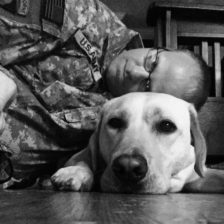My previous post was on Resources for Families…and I listed a few websites that have been helpful to us. When I was writing that and rereading it, I started to think about the ups and downs with PTSD.
There will be ups and downs…that’s a given.
I think if we try to understand them, give our Veterans some space, a cup of coffee, and a listening ear, that we can work through that trauma. Does that scenario work for everyone? No. But, how nice would it be to sit down and listen to what a Veteran has to say?
PTSD causes many emotions or little emotion. Some of the warning signs or things to look for are hypervigilance (always aware of surroundings, on edge), nightmares (reliving the moment, feeling the fear that took place), avoiding large crowds or places that might bring back unpleasant memories.
Possibly a branch of hypervigilance (or one that I can relate to because I see this with Sam) is analyzing. So, what does that mean (and if you were around Sam during the three-week trauma resiliency, you may know)? He will examine or study someone or a situation…how a person stands, their mannerisms, Sam will carefully scrutinize a situation to see if it is okay/safe, or if he is going to have a normal response to an abnormal situation.
Triggers are a big one…a car backfiring can be like a loud gunshot, driving over potholes could be a reminder of roads lined with IEDs. Seeing images on the news or even hearing of an assault or injury related to war can bring back memories.
Numbness…another big one…finding no words or ways to express emotions or feelings; avoiding memories that might bring positive or negative feelings, staying away from relationships–I am so thankful that Sam did not avoid me when we first started hanging out. Even though some of these signs or symptoms might have been lingering with him, I was lucky to start a friendship first, based on respect and trust. Something that was hard for him to do (trust).
A symptom that took me a little bit to understand was hyperarousal. Now, remember, I told you before I met Sam, what I knew of PTSD and these signs, symptoms, triggers were mostly from reading. Fancy words to describe the concept that someone might be “keyed up.” That could mean so much for a Veteran. Imagine, if you will, always looking for something that could be dangerous, or what if you had trouble sleeping every night? Not just from having your mind race, but from the actual thought of going to sleep and the images that may come to mind: seeing war again, seeing the dead.
Surprises–nope. Not for Sam. Coming up behind him, better not. He doesn’t really enjoy being caught off guard. In fact, some Veterans (notice some, not all) can be startled very easily. I often have to remind the kids to not stand directly behind him, or get so close that he feels as if they are breathing down his neck. It’s not that he doesn’t love them or want them around, it’s that those feelings–that hyperarousal–make him uncomfortable.
Does PTSD ever go away? No. To my knowledge, there really is no known cure for PTSD. Can it be curbed or coped with? Absolutely. Is there treatment for PTSD or therapy? You bet. There is hope and help for those with PTSD, and I have witnessed that first hand. There are people willing to work with Veterans and their families (I know this first hand, too). Sometimes you just have to step out of a comfort zone to find them. Sam is an example of that–coming out of what he thought was a comfort zone, what he thought was a good way to cope with PTSD. Isolation and avoidance were not working, as he said, “I lost the person I was before I went to war, and I thought I would never see that person again.” He knew he needed a change, more help, more tools to live with PTSD…and he found them. For that, I am forever grateful. <3


I love this… this relates to so many people that I know and have met here at the VA. Excellent stuff Cathrine.
Thanks, Jimmy! Yes–I think some of these can apply to others.